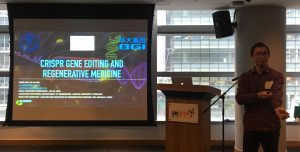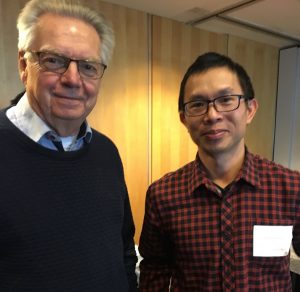CRISPR-based Epigenome Editing: Author Q&A with Alun Luo
 The CRISPR/Cas9 system has opened new horizons in what can be done with genome editing. Here we present an author Q&A with Alun Yonglun Luo discussing his new paper in GigaScience moving this technology towards epigenome editing and testing its efficacy and accuracy.
The CRISPR/Cas9 system has opened new horizons in what can be done with genome editing. Here we present an author Q&A with Alun Yonglun Luo discussing his new paper in GigaScience moving this technology towards epigenome editing and testing its efficacy and accuracy.
Modulating Methylation: Epigenome Editing
With our scope focussing the “biological big data” beat means GigaScience has covered in a lot of detail the implications from the exponentiation leap in our ability to read genomes (as well as publishing the raw material in our Data Note articles). The ability to edit genomes has had equally revolutionary implications, taking the field from hypothesis creation to application in model organism studies (see our review article) to implementation in the clinic as a new generation of molecular therapeutics. Fusing DNA methyltransferase domains to the nuclease-deficient CRISPR associated protein 9 (dCas9) means these technologies can also be adapted for epigenome editing, programming DNA methylation to silence or switch on already silenced genes. To take these technologies forward their specificities need to be thoroughly investigated to ensure there are not any problems with off-target effects.
Recently published work in GigaScience has done just this, with authors presenting a new dCas9 fusion protein system and for testing its ability for targeted epigenome editing on a genome-wide scale with single-base resolution. “Alun” Yonglun Luo from Aarhus University has lead a team of research in Denmark and China using quantitative bisulfite pyrosequencing, whole genomebisulfite sequencing, and ChIP-seq to investigate the characteristics of dCas9 methyltransferase-mediated DNA methylation in human cells. Alun has been working with genomics and animal cloning pioneer Lars Bolund (also an author on this paper) to scale up these techniques and build new research platforms for regenerative medicine with them in a new Lars Bolund Institute in Qingdao (see the announcement at ICG12). We met up with Alun and Lars (pictured) at a symposium at the Karolinska Institute’s new Ming Wai Lau Centre for Reparative Medicine in Hong Kong and asked some questions about epigenomic editing and their new paper. Following our traditional Q&A format here is Alun’s insight into the paper.
in GigaScience has done just this, with authors presenting a new dCas9 fusion protein system and for testing its ability for targeted epigenome editing on a genome-wide scale with single-base resolution. “Alun” Yonglun Luo from Aarhus University has lead a team of research in Denmark and China using quantitative bisulfite pyrosequencing, whole genomebisulfite sequencing, and ChIP-seq to investigate the characteristics of dCas9 methyltransferase-mediated DNA methylation in human cells. Alun has been working with genomics and animal cloning pioneer Lars Bolund (also an author on this paper) to scale up these techniques and build new research platforms for regenerative medicine with them in a new Lars Bolund Institute in Qingdao (see the announcement at ICG12). We met up with Alun and Lars (pictured) at a symposium at the Karolinska Institute’s new Ming Wai Lau Centre for Reparative Medicine in Hong Kong and asked some questions about epigenomic editing and their new paper. Following our traditional Q&A format here is Alun’s insight into the paper.
The easy ability to edit the genome with the CRISPR/Cas9 system has opened new horizons in what we can do in molecular biology. What applications are people trying to do in editing the epigenome?
Currently, the CRISPR epigenome editing system has been used to add or remove methyl groups to CpG dinucleotide residuals and to create histone modifications (acetylation/deacetylation). These technologies now allow us to regulate gene expression through targeted epigenome editing. Previously, the link between epigenetic modifications and their biological functions could only be derived from association studies. Now CRISPR-based epigenome editing tools to directly investigate e.g. whether epigenetic modification of a certain genomic locus leads to gene activation or inhibition. Aberrant epigenetic modifications are found in various of cancers, the CRISPR epigenome editing system could potential become a tool for targeted cancer therapy.
Has the CRISPR/Cas9 system been used much for epigenomic editing, and what has held back the utility of this technique so far? How does your new work in GigaScience advance upon what has been done so far in epigenome editing?
Limits in specificity and efficiency have been the major issue holding this back so far. Our study systematically highlights the precision and limits of CRISPR-based DNA methylation editing.
As applications for CRISPR/Cas9 are rapidly approaching clinical use, it is crucially important to assess the specificity of these approaches. How big a problem are off-target effects, and how are you and others trying to do to overcome them?
The off-target effects seem small enough not to severely jeopardize experimental research on epigenetic programming and somatic cell differentiation and evolution. However, improvements are needed for clinical use. To ensure the results were supported by the data we performed repeated (1+3) whole genome bisulfite sequencing on top of localized methylation studies of selected loci.
On top of sharing all the raw sequencing and RNA-seq, WGBS, and ChIP-seq data in NCBI and GigaDB, you’ve also shared the plasmids in Addgene. How do you hope others will build upon your work?
The area of genome/epigenome editing has great promise in basic science as well as clinical practice. We hope to contribute to global efforts in this field – and speed up international collaboration.
What is next for this research? As you are working with your co-author Lars Bolund in the set-up of the new Lars Bolund Institute in Qingdao, will large-scale CRISPR/Cas9-based research be a focus of the new centre?
CRISPR/Cas9-based research will be an important part of the new Institutes 2 x 2 strategy – two technical platforms (CRISPR-editing and cell/organoid cultures) and two experimental animal systems (regenerative biology models and preclinical pig models).
Further Reading:
Chen L, Tang L, Xiang H, Jin L, Li Q, Dong Y, Wang W, Zhang G. Advances in genome editing technology and its promising application in evolutionary and ecological studies. Gigascience. 2014 Oct 30;3:24. doi: 10.1186/2047-217X-3-24.
Lin L, Liu Y, Xu F, Huang J, Daugaard TF, Petersen TS, Hansen B, Ye L, Zhou Q, Fang F, Yang L, Li S, Fløe L, Jensen KT, Shrock E, Chen F, Yang H, Wang J, Liu X, Xu X, Bolund L, Nielsen AL, Luo Y. Genome-wide determination of on-target and off-target characteristics for RNA-guided DNA methylation by dCas9 methyltransferases. Gigascience. 2018 Mar 1;7(3):1-19. doi: 10.1093/gigascience/giy011.